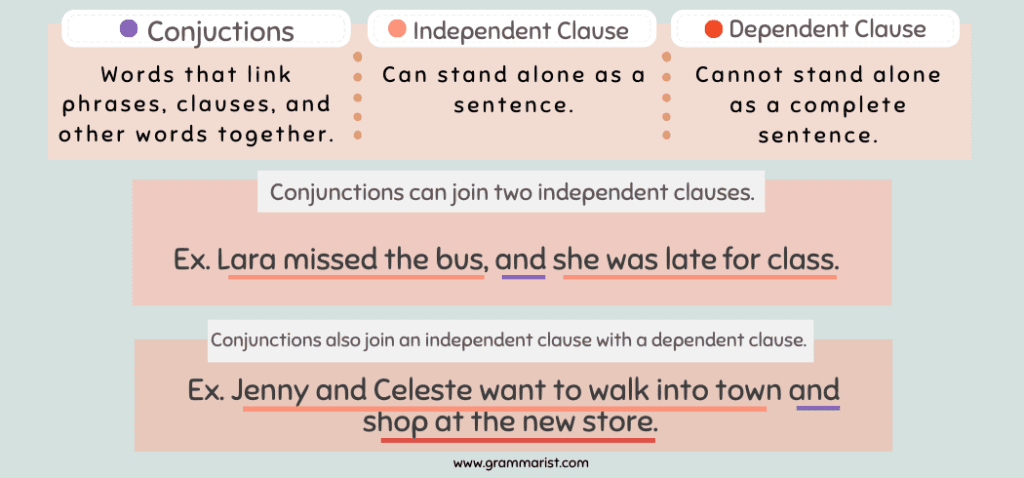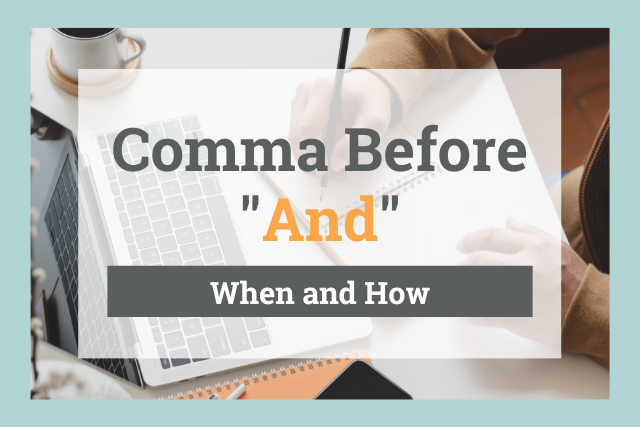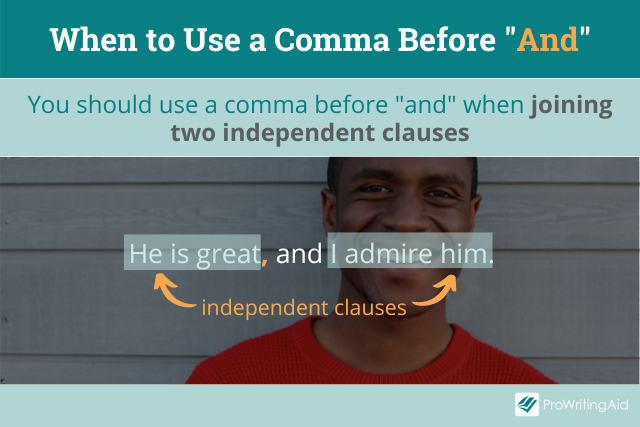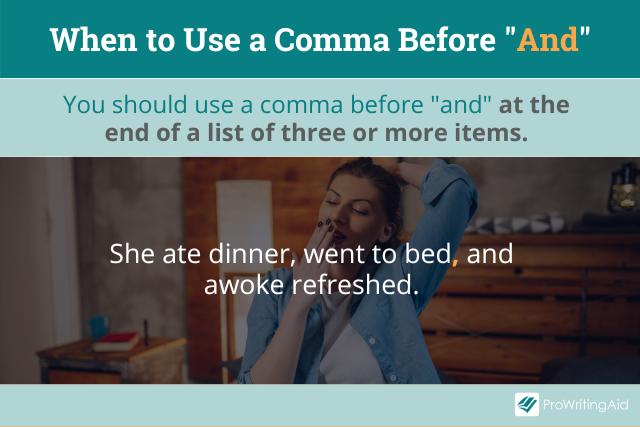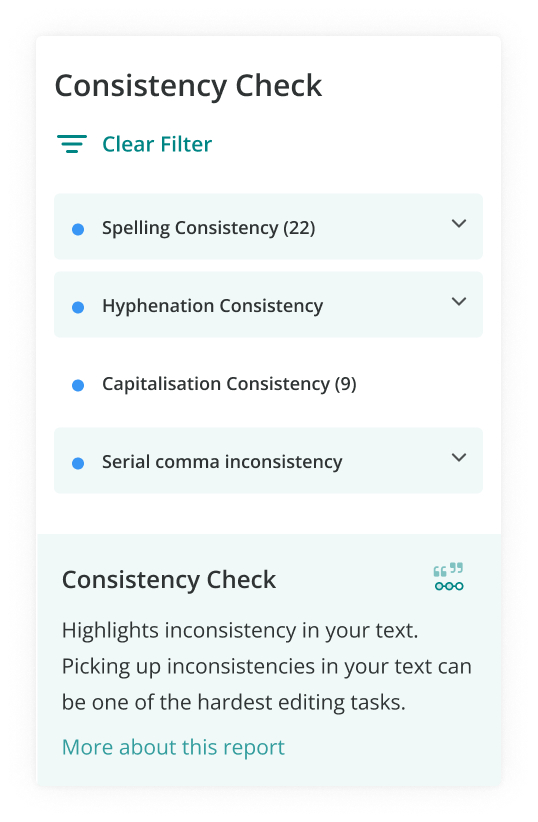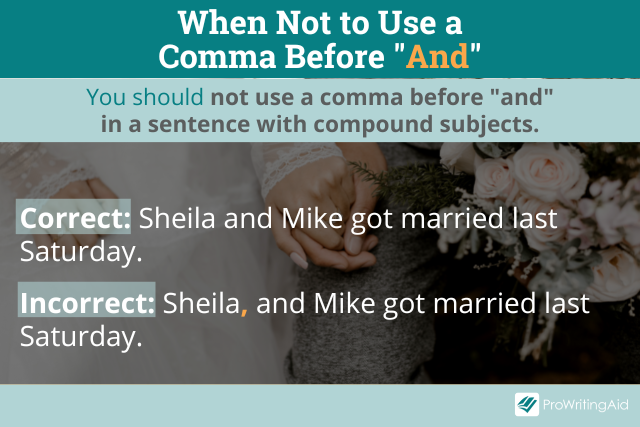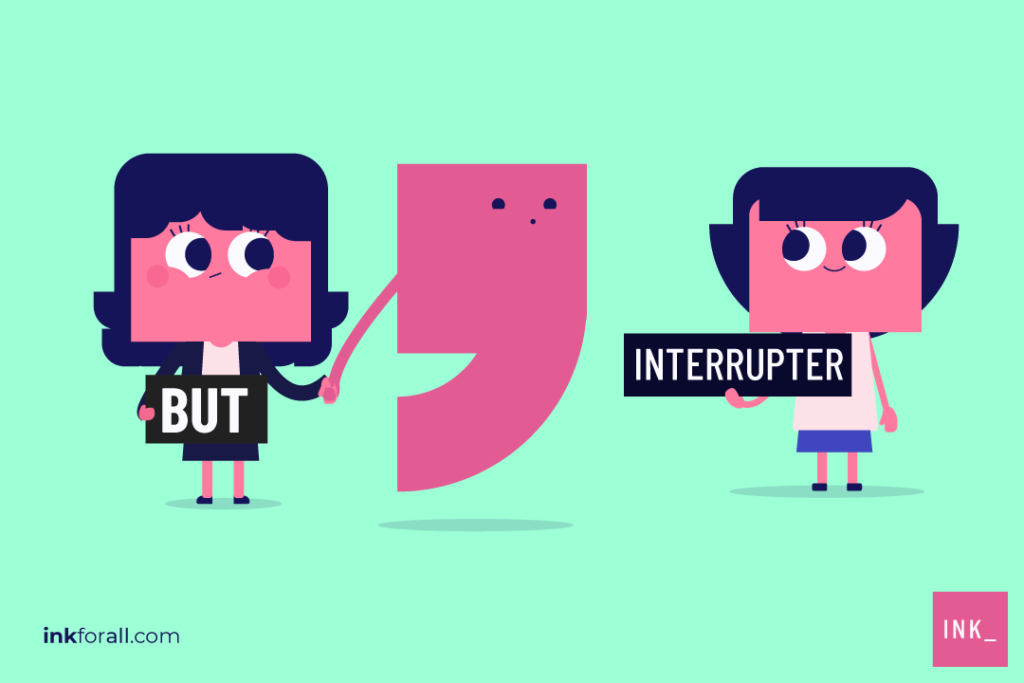Commas are probably one of the most confusing punctuation marks to use, and even I struggle to find ways to help my students determine where they belong.
One of the most commonly asked questions I hear surrounds whether to place a comma before or after the word “and.” Unfortunately, the answer is not quick or simple. However, the comma rules concerning the word “and” is not difficult to understand.
I’m going to start simple and explain how the word “and” is used and then provide rules on punctuation surrounding comma usage so you can understand where they belong together. I’ve also provided plenty of examples below.
Common Coordinating Conjunctions and Compound Sentences
Conjunctions are words that link phrases, clauses, and other words together. They allow you to form compound-complex sentences to enhance the flow of your writing and speech.
Coordinating conjunctions include the words for, and, nor, but, or, yet, and so. The guide to comma usage in relation to conjunction use are the same for all of them, but the word “and” is more used than any other choice.
Conjunctions can join two independent clauses or clauses that could work as stand-alone sentences.
For example, the following two independent clauses:
- Lara missed the bus. She was late for class.
Becomes
- Lara missed the bus, and she was late for class.
Conjunctions also join an independent clause with a dependent clause or clause that cannot stand alone as a complete sentence.
For example:
- Lara needs to start getting to class on time and make sure her homework is complete.
Rules of Comma Usage
There are six basic rules of comma use, but I find it is much easier to teach each rule independently of one another with plenty of examples. Such is the case with commas and conjunctions.
Using “And” to Join Two Independent Clauses: Comma BEFORE “And”
When “and” joins together two independent clauses, a comma needs to be placed before the “and.” Independent clauses are complete sentences, but their conjoining makes a complex-compound sentence. The comma works to indicate this use.
For example:
- I hate having to get up early for work, and getting chores done at that time of the morning is exhausting.
- It hasn’t rained in our town or the surrounding areas, and the lack of rain is starting to make everyone very anxious.
- I’m so glad the end of the week is nearing, and I can’t wait until I can sleep in this weekend.
Using “And” with a Dependent Clause: No Comma
If you are joining together an independent clause with a dependent clause, you do not use a comma.
For example:
- Jenny and Celeste want to walk into town and shop at the new store.
- Wyatt wanted to study Marine Biology and go to a summer camp for more experience.
- Sarah got in big trouble at school for fighting and was suspended for ten days.
Using “And” with Short Independent Clauses: No Comma
Even though they are technically independent, it is acceptable to avoid the comma for shorter sentences.
For example:
- Emmett likes trains and Emily likes horses.
- Mary likes math and John likes writing.
- Javier likes football and Mark likes lacrosse.
Using “And” with List Items:
Depending on how many items you have to list determines whether you use commas in lists with the “and.” There are also multiple ways to approach whether you use a comma or not, which can cause quite a bit of confusion.
Take a look at the examples below to determine which approach works best for you.
Two Items: No Comma
When listing two items, you do not use a comma before the “and.”
For example:
- I need to run to the store for milk and butter.
- She couldn’t decide between art and choir.
- He played in the band and played football.
Three or More Items: Serial Comma BEFORE “And”
The use of a comma before the word “and” when listing three or more items has been a topic of hot debate for many years. This quirk of comma usage is called a serial comma – a comma used in a series of items. It is also called the Oxford comma.
The Oxford comma’s rules state that a comma belongs between the last two items in a series of three or more items to avoid ambiguity. The serial comma controversy is addressed in the the AP Style Guide stating the Oxford comma is grammatically incorrect. But, linguists everywhere will agree it is a grammatical option.
In fact, there has been a lawsuit about a job description that offered two different interpretations of an exception rule: in this case, whether overtime was owed. The judge ruled an Oxford comma was required to include the last item in the list concerning exception, but since it was not used, the item was not part of the list, and overtime was indeed owed.
I also teach the Oxford comma in order to ensure clarity and avoid confusion. Without it, some pretty amusing situations can occur.
For example:
- Rachel finds inspiration in cooking, her dog and family.
- We went to the concert with neighborhood friends, Grandma and Grandpa.
The first sentence sounds like Rachel cooks her dog and her family. In the second sentence, it sounds like the neighborhood friends are named grandma and grandpa.
Instead of accidentally creating this confusion, simply use an Oxford comma to create clarity.
For example:
- Rachel finds inspiration in cooking, her dog, and her family.
- We went to the concert with neighborhood friends, Grandma, and Grandpa.
When to Use Commas AFTER “And”
A comma is almost never used after the word “and.” However, there are a few exceptions. In general, do not place a comma after “and” unless the following is true:
“And” is Used to Introduce a Parenthetical Expression
A parenthetical expression is a non-essential phrase that is offset from the main sentence to add detail or information.
For example:
- I have to drive to Texas every two weeks for a doctor’s appointment, and, if I’m lucky, I have extra time to do a little shopping.
“And” is Used in a Line of Dialog
Written dialog may require a comma following an “and” depending on the style and tone the author is trying to create with a character.
For example:
- “And,” Michael dictated, “you have to be up two hours before daybreak if you want to get there on time.”
Let’s Review
A comma is almost never used after the word “and,” barring a few exceptions, but it is commonly used before when you combine two complete sentences into a compound sentence or when listing more than two items.
It is important to use commas properly to avoid overuse and help ensure writing clarity. Like I tell my students, when you look at one grammar rule at a time and practice its application, you will almost always remember its use.
Like many English comma rules, whether or not you use a comma before «and» depends on the situation. There are two instances when you should use a comma before «and.»
First, use a comma when «and» joins two independent clauses. You can also use a comma when «and» precedes the last item in a list. This is called an Oxford comma.
Today, we’re taking a closer look at the rules about using a comma before «and» in sentences.
If your comma skills are rusty, you can always use ProWritingAid’s free grammar checker to find all your misplaced and missing commas.
Do You Put a Comma Before «And»?
There are two main instances when you should put a comma before «and» in a sentence. Let’s dive into each rule in more detail.
Comma Before «And» When Joining Independent Clauses
To understand how to use a comma before «and,» you need to understand the difference between independent clauses and dependent clauses.
An independent clause is a statement that can stand alone as a complete sentence. Independent clauses always have a subject, a verb, and express a complete thought.
A dependent clause is a statement that cannot stand alone as a complete sentence. It may have a subject and a verb, but it is an incomplete thought.
Coordinating conjunctions can link two independent clauses. The seven coordinating conjunctions are: for, and, nor, but, or, yet, so.
When «and» combines two independent clauses, you should use a comma before “and.” This rule applies to any coordinating conjunction that joins two independent clauses.
Correct: He is great, and I admire him.
Incorrect: He is great and I admire him.
Both clauses can stand alone as a complete sentence. We could say, «He is great. I admire him.» We used «and» to join the independent clauses, so we put a comma before «and.»
It’s important to note that you should only use a comma to join independent clauses if a coordinating conjunction like «and» is present.
If you combine two independent clauses with just a comma and no conjunction (e.g. He is great, I admire him.), this is called a comma splice. It’s grammatically incorrect.
Comma Before «And» in a List
The other situation where you should place a comma before «and» in a sentence is in a list. The Oxford comma, also called a serial comma, precedes «and» before the last item in a list.
To use an Oxford comma, there should be three or more items in a list. If there are only two items, you do not need a serial comma before «and.»
Correct: She ate dinner, slept all night, and awoke refreshed.
Incorrect: She ate dinner, and awoke refreshed.
The Oxford comma is grammatically correct, but it is not required. It used to be more common not to use it, but it’s become the preferred comma usage.
If you prefer to write a list without the Oxford comma, that’s fine. However, you should check any style guides if you’re doing business or technical writing.
The important thing is to be consistent with your serial comma usage. Don’t use the Oxford comma part of the time and leave it out the rest.
ProWritingAid’s Consistency Report will help make sure you are sticking with one rule or the other.
Comma Before «And More»
You can also use an Oxford comma before «and more» if your list ends with this phrase. In these situations, «more» acts as the last item in a list.
Let’s look at an example of how this might look.
- The rehearsal dinner included tacos, enchiladas, elote, frijoles charros, and more.
However, the comma before «and» is optional because it is a serial comma.
Do You Put a Comma After «And»?
If you use a comma with «and,» it should always precede the word «and.» You should never put a comma after the word «and.»
This rule applies to both independent clauses joined by «and» and lists of three or more items, as well as any other time «and» might appear in a sentence.
It also applies to all other coordinating conjunctions; you should never put a comma after a coordinating conjunction.
Correct: We met for lunch, and we spent two hours chatting at the restaurant.
Incorrect: We met for lunch and, we spent two hours chatting at the restaurant.
Correct: My pets include two rats, three hamsters, and a ferret.
Incorrect: My pets include two rats, three hamsters and, a ferret.
Remember, commas can precede «and» but can’t follow it.
When Shouldn’t You Use a Comma Before «And»?
You should only use a comma before «and» in a list or when joining two independent clauses.
«And» sometimes joins an independent clause with a phrase that isn’t a complete thought. This incomplete thought usually takes the form of either a compound subject or a compound predicate.
When this happens, do not use a comma before «and.»
Here’s an example of «and» in a compound subject:
Correct: Sheila and Mike got married last Saturday.
Incorrect: Sheila, and Mike got married last Saturday.
Sheila and Mike are both subjects, so this is a compound subject. No comma is required.
Now, let’s look at an example of a compound predicate that uses «and.»
Correct: The baby drank a bottle and went to sleep.
Incorrect: The baby drank a bottle, and went to sleep.
In this example, «went to sleep» is not a complete thought. There’s no subject, so it’s not an independent clause and therefore does not require a comma.
Examples of Comma Before «And» in Sentences
Here are a few more examples of how to use a comma before «and» in a sentence.
- A librarian can recommend a good book, and they can also help you with research.
- Lavender plants smell great, and they also repel mosquitos.
- After work, I went to the grocery store, the post office, and the gas station.
- Christy got gift cards, a bottle of wine, bath bombs, and new shoes for her birthday.
Comma rules can be tricky because there are so many scenarios where we need this versatile punctuation mark.
Just remember that you should only put a comma before «and» when joining two independent clauses or in a list of three or more things.
Take your writing to the next level:
20 Editing Tips From Professional Writers
Whether you are writing a novel, essay, article, or email, good writing is an essential part of communicating your ideas.
This guide contains the 20 most important writing tips and techniques from a wide range of professional writers.

Certain grammatical situations require the use of a comma beforeand. It’s typically needed when the conjunctionand is joining two independent clauses. Or if you’re using it in lists that require an Oxford comma.
This brief guide will shed light on the age-old question of whether to use a comma before the word and.
Main Comma Before And Takeaways:
- A comma is a form of punctuation that indicates a pause in a sentence and separates items in a list.
- Commas should be used before and when joining two independent clauses or when compiling a list.
- Commas can separate adjectives, offset nonessential phrases, and introduce direct quotations.
- Oxford commas are also known as serial or Harvard commas.
- Serial commas are used after the next-to-last item in a list and before the and.
- The AP Stylebook doesn’t advocate the use of the Oxford comma.
Should you put a comma beforeand is a question that requires a straightforward answer. Either you do, or you don’t, right?
Is There a Comma Before the Word and?
Unfortunately, the answer isn’t entirely so black and white. When to use a comma beforeand in a sentence depends on several factors:
- Whether the and is linking two independent clauses
- If the and is separating items in a list or series
- Whether you’re using an Oxford (or serial) comma
- If a pause is necessary
- What style guide you’re following
What is the Comma Before And Called?
The answer to that depends on how you’re using the word and. In general terms, a comma falls under the category of a punctuation mark. It’s often used to indicate a pause in a sentence or to separate items in a list. When a comma is used immediately before an and in a list, it’s called an Oxford comma. Others may refer to the comma before and as a serial or Harvard comma.
What are the 8 Commas Rules?
Whether it comes before and or elsewhere in a sentence, following basic comma rules can make using this misunderstood punctuation mark a breeze. In a nutshell, we use commas to:
- list items,
- separate adjectives,
- join independent clauses,
- offset introductory and nonessential phrases,
- introduce quotations, and
- maintain flow.
Whew! Take a breath. Let’s take a closer look at each of these rules.
Rule 1: Use a Comma in a Series or List
When creating a list of three or more simple words, items, or concepts, use a comma to separate each word or word group.
Note: Using a comma after the next-to-last item in a list is a stylistic choice and may depend on the style guide you’re following.
Rule 2: Separate Adjectives With a Comma
When you use more than one adjective to modify a noun or pronoun, use commas to separate them. This is only true if the adjectives’ order is interchangeable.
Note: This could easily read: She had a healthy, happy baby.
Rule 3: Use a Comma When Joining Two Independent Clauses
When a conjunction (for example: and, or, and but) links two independent clauses, you need to put a comma before the conjunction.
Note: An independent clause must have a subject and verb. It should express a complete thought.
Rule 4: If a Sentence Begins With a Dependent Clause, Use a Comma After It
If a sentence begins with an introductory phrase or dependent clause, it should have a comma immediately after it.
Rule 5: Offset Nonessential Words, Phrases, or Clauses With Commas
If a sentence contains nonessential words, phrases, or clauses, use commas to set them apart. These nonessential sections often begin with words such as who or which. They may be removed from a sentence without altering its meaning.
Rule 6: Commas Introduce Direct Quotations
Direct quotations, such as dialogue, should be preceded by commas.
Commas may also be used to express interruptions to direct quotations.
Rule 7: Commas Set Off Phrases That Interfere With Sentence Flow
Commas can be used to set apart phrases that interrupt the flow of a sentence. These may include expressions such as by the way, after all, and nevertheless.
Rule 8: Commas Set Off Names, Nicknames, and Titles
When directly addressing a person, use a comma to set off their name, nickname, title, or term of endearment.
Do You Use a Comma Before “And” When Joining Two Sentences?
Yes. When joining two independent clauses or sentences, “and” acts as a coordinating conjunction. The rule states that a comma must be used before a conjunction when it’s joining two independent clauses or sentences. This rule is applicable to other coordinating conjunctions like but, so, and or, to name a few.
Commas Before And: An Overview
Commas BeforeAnd are used primarily in two specific situations:
1. Joining Independent Clauses With a Conjunction
An independent clause is a phrase that expresses a complete thought. It must have both a subject and a verb. In other words, it can stand alone as a sentence.
A sentence can contain two independent clauses if they’re linked by a conjunction such as and, or, and but. (Without the conjunction, two independent clauses typically form a run-on sentence). A comma is required after the final word of the first clause, before and (or whatever conjunction you’re using).
Take these two independent clauses:
If you join them together with only a comma, they form a comma splice.
If you add an and after the comma, the sentence becomes grammatically correct.
Exceptions to the rule:
If the two independent clauses are short and have a strong connection, then the comma should be omitted. Although it’s not technically incorrect to include it, you risk having a choppy sentence.
2. Before the Next-To-Last Item in a List
Commas are almost always used to separate items in a list or series that contains three or more things. More specifically, some lists contain a comma that’s known as the Oxford comma. This punctuation sits immediately after the list’s next-to-last item, just before the and or the or.
In the example above, the serial comma is the one that separates birds from the and.
Exceptions to the Rule: In simple lists, a comma beforeand isn’t always necessary and doesn’t actually enhance a sentence. Sometimes, the omission of this serial comma is even advisable.
In fact, the Oxford comma is a hotly debated point in modern grammar, and ultimately, it comes down to a stylistic choice.
Certain style guides, such as the AP Stylebook, don’t advocate using this serial comma unless it’s absolutely necessary for preserving a sentence’s meaning.
Comma Confusion: Final Thoughts
Let’s face it. Commas can be confusing. They’re also important. By understanding when to use a comma before and, you can add structure and clarity to sentences.
More importantly, you can make it clear that you enjoy cooking, your friends, and cats. And that no, you don’t enjoy cooking your friends and cats.
Quick Comma Before and Quiz
Comma Before And Question #1
A. When joining two independent clauses
B. In a series or list
C. To introduce direct quotations
D. All of the above
Correct!
Wrong!
The answer is D. Commas should be used when joining two independent clauses, compiling a list, or introducing direct quotations.
Comma Before And Question #2
A. Oxford comma
B. Serial comma
C. Cambridge comma
D. Harvard Comma
Correct!
Wrong!
The answer is C. The Oxford comma comes immediately before an «and» in a list. Others refer to it as a serial comma or Harvard comma.
Comma Before And Question #3
A. AP stylebook
B. The MLA handbook
C. The Chicago Manual of Style
D. The Elements of Style
Correct!
Wrong!
The answer is A. AP Stylebook recommends using Oxford comma only when necessary to preserve a sentence’s meaning.
Comma Before And Question #4
A. His bright, yellow coat was stolen.
B. His bright yellow coat was stolen.
Correct!
Wrong!
The answer is B. You can separate adjectives with a comma only when the adjectives’ order is interchangeable.
Comma Before And Question #5
Correct!
Wrong!
The answer is TRUE. An independent clause can stand alone.
Comma Before And Question #6
A. Jack loves video games and he enjoys playing board games.
B. Jack loves video games, and he enjoys playing board games.
Correct!
Wrong!
The answer is B. Use a comma after the final word of the first clause, before “and.”
Read More: When To Use Comma Before Such As: The Definitive Guide
In American English usage, many writers and editors feel that a comma should precede and with three or more items in a series.
Example: I would like to order a salad, a sandwich, and dessert.
Newspapers and magazines do not generally use this rule as print space is too valuable to use on what might be considered extraneous punctuation. However, print publications will use the final comma before and if it is needed to avoid confusion.
Example: Her $10 million estate was split among her husband, daughter, son, and nephew.
Omitting the comma after son would have led the reader to believe that the son and nephew had to split one-third of the estate (each receiving one-sixth) rather than understanding that each relative received one-fourth of the estate.
Advertisement
If the article or the existing discussions do not address a thought or question you have on the subject, please use the «Comment» box at the bottom of this page.
Punctuation matters if you want to deliver a precise and crisp message. It may seem that there is nothing that hard in using commas; however, comma rules might be really tricky.
We’ve set up a list of comma rules, and examples of embarrassing mistakes that will help you to enhance your writing style and avoid misunderstanding.
Rule #1. You need a comma before coordinating conjunction linking two independent clauses
A group of words that can easily serve as a separate sentence is called an independent clause. When you want to combine two such independent clauses in one sentence using a coordinating conjunction (and, but, or, so, etc.), there should be a comma before this coordinating conjunction.
I went to the mall to score new boots, but I failed to find my size.
Both clauses in this sentence could stand alone as separate sentences. Coordinating conjunction but combines them into one sentence, so we should use a comma.
Rule #2. A comma is used to separate items
When you have a sentence with a list of items, you should separate them with commas.
John was obsessed with parties, girls, and sports cars.
If you have such a queue, you should use a comma to separate it. However, there are slight differences in comma usage in different English styles. Look at the example above, see a comma before “and”? It is called “Oxford comma,” and some styles require its usage or not.
For example, the style guide for newspaper reporters called AP Style does not require its use. However, in American and Canadian English, it is a common thing to use the Oxford comma. So, if you are writing in American English, it is better to stick with it.
Here is what can happen if you fail to follow this rule:
Rule #3. A comma is used to join dependent and independent clauses
If in your sentence there are two clauses, and one depends on another and follows it, you should not separate them with a comma. But in the case when a dependent clause stands at the beginning of a sentence, it is right to put a comma before the clause it depends on.
Examples:
You should read more if you’re going to become a journalist. (The dependent clause follows the one it depends on, so no comma is needed.)
If you’re going to become a journalist, you should read more. (The dependent clause starts the sentence, so the comma is needed after it).
Rule #4. You should use commas after introductory words
Sometimes you need an introductory word (“however”) or group of words (“on the other hand”) to start your sentence. There might be different reasons for it, including providing more information and preparing the reader to the main part of a sentence. The rule is that a comma should follow such words and group of words.
Finally, I had enough money to buy this car.
Tip: it is common to use adverbs as introductory words, and lots of them end in “ly.” So, if you have a word ending in “ly” at the beginning of your sentence, be sure to put a comma after it.
Rule #5. Use a comma in sentences beginning with “Yes” or “No”
This one is a quite simple rule. If you have “yes” or “no” at the beginning of a sentence, you need a comma after them. Easy.
Yes, I’d like to have some more ice cream.
Rule #6. A comma is used when you need to interrupt a sentence to provide more information
When your sentence is interrupted by a phrase that is not grammatically connected with it, you need to set this phrase off with commas.
This car I told you about, which had this nice built-in audio system, was bought yesterday by some banker.
It is really important to follow this rule.
Rule #7. You should use a comma with direct quotatio
It is a simple rule many people often forget to follow. When you see a direct quotation, be sure to use a comma.
“I’d rather die than accept this job offer,” she told her friend.
Exact punctuation here is a matter of style, similar to the Oxford comma. In the American and Canadian English, it is common to put the comma inside the quotation mark, while the British style accepts placing the comma after it.
Rule #8. Commas separate elements in an address
When you are writing an exact address with building number, road, city, and state, it is correct to separate these elements with commas.
Our new office is located at 350 Lincoln Road, Miami Beach, FL 33139.
Rule #9. Use a comma to separate elements in dates
The same as with addresses, when you have a sentence with weekday, month, day, and year mentioned, comma rules tell that you need to separate them.
Sunday, March 3, 2019, was a day we’ve finally launched our Chrome and Firefox browser extensions.
Tip: you need a comma after the date as well, it will separate it from the rest of the sentence. However, if your date consists only of day and month, you don’t need to use a comma as a separator.
Rule #10. You need to use commas with titles
If you write a person’s name followed by his or her title, you need to put one comma before it, and one after to separate it from the remainder of the sentence.
Kimberly Johnson, a TV host, is now running for a major in her home town.
Rule #11. You need commas in numbers as well
When you have a number longer than four digits, use commas to separate them into groups of three. You should count three digits from the right.
Good: 50,000
Bad: 55,000,00
Rule #12. Use commas with negations
If your sentence contains a negation, i.e. “the contradiction or denial of something” as dictionaries explain it, you need to set it off with commas.
I went to Barcelona, not Madrid, for my vacation this year.
Tip: you still need a comma even if the negation occurs at the end of your sentence.
Rule #13. Always use a comma for direct address
When you need to address someone or something in a sentence directly, it is correct to put a comma before it.
You should allow more privacy on Facebook, Mark.
Look at what will happen if you fail to follow this rule:
Rule #14. Use commas to separate coordinate adjectives
If two adjectives independently modify a noun, they are called coordinate adjectives, and you need to separate them with a comma.
If you can put “and” between adjectives or rearrange them, and the sentence will still make sense, then you have coordinate adjectives and need to separate them with a comma.
Travel is a fun, exciting way to spend your time. (You can add “and” or rearrange adjectives with no harm to the sense of a sentence.)
Rule #15. Appositive adjective require commas
In English, there is such a thing as an appositive adjective. It is used to emphasize the description of a noun or pronoun and follows them. You need to use commas to set them off.
Hugo Boss, the type of perfume he preferred, was the one she always loved.
You can meet such constructions in fiction or academic writing. It is undesirable to use appositive adjectives in your writing as they make it wordy and harder to read.

